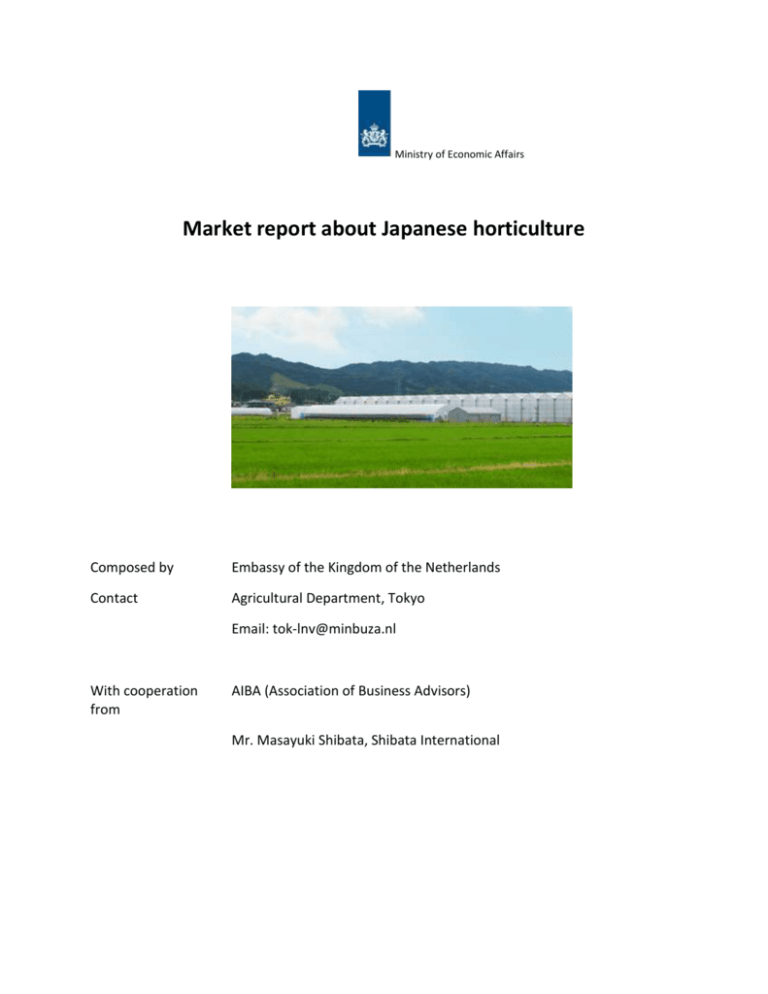Japan Greenhouse Horticulture Association
advertisement

Ministry of Economic Affairs Market report about Japanese horticulture Composed by Embassy of the Kingdom of the Netherlands Contact Agricultural Department, Tokyo Email: tok-lnv@minbuza.nl With cooperation from AIBA (Association of Business Advisors) Mr. Masayuki Shibata, Shibata International Summary In Japan where the food self-sufficiency ratio is about 40 percent, expectation for the development of plant factories is high. The development of greenhouses increased until 1999, but after 1999 both glass and vinyl greenhouses have continued to decrease due to the aging of the farming population. Many plant factory operators had many issues to deal with and eventually withdrew from the business. Stable business plans should be promoted even more in the future. Market information Japanese horticulture can be categorized into the cultivation of fruit trees, vegetables and (ornamental) flowers. Both outdoor cultivation and cultivation in vinyl houses and glass greenhouses (which enable farmers to adjust the season of the harvest) are very popular. For example, there are agricultural houses called plastic green houses or vinyl houses, which have outside walls covered principally with polyvinyl chloride film for agricultural use. There are also similar agricultural houses called “glass greenhouses”, which use solid steel such as I-beam and external walls covered with glass. Recently there are also houses using PVC film, polyolefin film and fluorine film (hard film) as covering materials. Houses covered with glass are called “glass greenhouses”. These are more durable and larger than vinyl houses. As vinyl houses are simple frame buildings, no fixed property tax is charged for them. These vinyl houses are also called “pipe houses”, as many steel pipes are used for its frame. Application for a building certificate under the Building Act in article 6 is required for the building of glass green houses for agricultural use, with a roof of glass or polycarbonate boards which cannot be removed easily. Frame of a vinyl house Vinyl house for strawberry cultivation Glass greenhouses Exterior of a vinyl house Glass green houses The table below was provided by the Ministry of Agriculture, Forestry and Fisheries. It shows the statistics regarding the transition of the installation area and the cultivation area of horticultural facilities. Transition for the installation area and cultivation area of horticultural facilities (unit: ha) year 1991 1997 1999 2001 2003 2005 2007 2009 class installation area growing area Glass House vegetable 862 901 1,042 869 889 911 873 811 Flower etc 1,062 1,201 1,278 1,232 1,242 1,206 1,145 1,096 Fruit etc 208 161 155 155 146 145 139 131 Sub total 2,132 2,264 2,476 2,255 2,277 2,262 2,157 2,039 vegetable 1,926 2,108 2,313 2,042 1,938 1,930 1,717 1,758 Flower etc 1,458 1,704 1,761 1,893 1,711 1,572 1,440 1,369 209 161 144 125 142 134 133 125 3,593 3,973 4,218 4,060 3,791 3,636 3,289 3,251 vegetable 33,972 35,841 36,441 35,889 35,389 35,329 34,364 33,079 Flower etc 5,415 7,423 7,631 7,462 7,451 7,401 6,935 6,649 Fruit etc 5,646 7,044 6,969 7,563 7,172 7,217 7,153 7,282 計 45,033 50,307 51,040 50,913 50,011 49,947 48,451 47,010 vegetable 46,570 48,458 50,218 47,759 46,575 47,653 45,500 44,294 Flower etc 6,993 9,328 9,295 10,256 8,617 9,060 9,124 7,863 Fruit etc 5,662 7,230 6,793 7,489 7,068 7,517 6,967 6,773 計 59,225 65,017 66,306 65,504 62,260 64,230 61,591 58,930 Fruit etc Sub total installation area growing area Vinyl house According to these statistics, both glass houses and vinyl houses were at a peak in 1999 and decreased after that year. In the field of fruit tree horticulture, the cultivation of grapes is most popular (34,074,000 m2 in growing area and 50,831 ton in amount of harvest). Apart from this, many fruits are cultivated in greenhouses, such as citrus fruits (including Satsuma mandarins), loquats, cherries, persimmons, figs and pears. Furthermore, in the field of vegetable horticulture tomato has the biggest crop (75,356,000 m2 in growing area and 56,451 ton in amount of harvest). Spinach, strawberries, cucumbers, melons, water melons, green onions, greenhouse melons, eggplants, chive, pepper and other vegetables are cultivated in greenhouses. Finally, in the field of flowers and ornamental flowers, chrysanthemum has the biggest crop (29,441,000 m2 in growing area and 1,191,752 ton in amount of harvest). Carnations, roses, lilies for cut flower and many other flowers are cultivated in greenhouses. Other than the above, 480,768 ton of potted flowers are also cultivated in greenhouses in an area of 17,932,000 m2. (Brief extract taken from 2008-2009 statistics provided by Ministry of Agriculture, Forestry and Fisheries). According to research by the Ministry of Agriculture, Forestry and Fisheries in 2007 regarding the spread of energy-efficient devices and facilities, there are 22,308ha of glass greenhouses and vinyl houses with warming devices, and 17,924ha with curtain devices (41.1% and 35.4% respectively). Greenhouses with carbon dioxide generators take up 1,369ha. Nutricultural facility In 2007 the installation area for nutricultural facilities was 1,686ha, a 3.2% increase compared with 2005. The area used for different crops was 1,372ha for vegetables (increased by 5.2%) and 312ha for (ornamental) flowers (decreased by 7.1%) respectively. Rock wool cultivation decreased by 5.7% compared with 2005 (587 ha), but still takes up 34.8% of the installation area of nutricultural facilities. The main products cultivated in the greenhouses of nutricultural facilities are tomatoes (502ha, decreased by 2%), strawberries (485ha, increased by 21.5%), Japanese honewort (99ha, decreased by 1%) and green onion (63ha, increased by 9.3%). We have to point out that there is a crucial issue regarding the waste of plastic used in agriculture (in particular in vinyl houses). Along with the development of horticultural facilities, the amount of waste of used plastic has increased year by year. However, recently it is starting to decrease and the amount of waste in 2009 was 132,486 tons (decreased by 12.2% compared with 2007). (Above statistics are based on research about greenhouse horticulture conducted by the Ministry of Agriculture, Forestry and Fisheries up to 2009). According to research by Yano Research Institute, the market size for glass greenhouses and vinyl houses was 17,355 million yen on manufacturer’s shipment basis between July 2008 and June 2009. Glass greenhouses and vinyl houses take a market share of 14% and 86% respectively, therefore vinyl houses clearly account for the majority of the market share. Plant factories According to research by Mitsubishi Research Institute regarding plant factories, the annual sales turnover was estimated at 4.8 billion yen in 2009. Furthermore, as of March 2011 there are 64 plants with complete artificial illumination systems, 16 plants with harness sunlight systems and 12 plants with 100% sunlight systems. The most important crops of plant factories are lettuces such as leaf lettuce, Boston lettuce and frill lettuce. Additionally a variety of herbs, mizuna (water green), rocket salad (rucola) and tomato seedlings are cultivated in the plant factories. We have to say that the products that can be cultivated are still limited. Industry associations Japan Greenhouse Horticulture Association Yamaichi Bldg 4F, 3-6-17, Higashi-Nihonbashi, Cyuo-ku, Tokyo 103-0004 TEL: 03-3667-1631 FAX: 03-3667-1632 www.jgha.com Japan Gardening Society Sogei-Moto Yoyogi Bldg, Moto-Yoyogi-machi, Shibuya, Tokyo 151-8671 TEL: 03-3465-5171 FAX: 03-3465-0051 www.gardening.or.jp National Federation of Agricultural Cooperative Associations (JA ZEN- NOH) JA Bldg. 1-31-1 Otemachi, Chiyoda-ku, Tokyo 100-6832 TEL: 03-6271-8111 www.zennoh.or.jp www.zennoh.or.jp/about/english.index.html Japan Floral Marketing Association Toetsu Hakutaka Bldg., 5F, 4-9 Yonbancho Chiyoda-ku, Tokyo 102-0081 TEL: 03-3238-2700 FAX: 03-3238-2701 www.jfma.net Trade fairs and journals International Agricultural Material EXPO AGRITECH JAPAN www.agritechjapan.jp International Garden Expo GARDEX www.gardex.jp International Flower EXPO IFEX www.ifex.jp Above three exhibitions are organized by Reed Exhibitions Japan Ltd and Japan Floral Marketing Association. Agro-Innovation Japan www.jma.or.jp/ai/en Organized by Japan Management Organization





